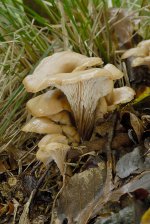The following fungi were photographed in Binning Wood, East Lothian Scotland. It's an area of woodland that has a lot of Scots Pine but also some broad-leaf. I'd realy appreciate some assistance with identification/ confirmation of my guesses.
http://www.pbase.com/grahamcheckley/image/67488595 (Sulphur Tuft?)
http://www.pbase.com/grahamcheckley/image/67488559 (Russula paludosa?)
http://www.pbase.com/grahamcheckley/image/67299614 (?)
http://www.pbase.com/grahamcheckley/image/67299606 (?)
http://www.pbase.com/grahamcheckley/image/67245540 (Amethyst Deceiver?)
http://www.pbase.com/grahamcheckley/image/67209794 (Beechwood Sickener?)
http://www.pbase.com/grahamcheckley/image/67209734 (?)
Regards,
Graham.
http://www.pbase.com/grahamcheckley/image/67488595 (Sulphur Tuft?)
http://www.pbase.com/grahamcheckley/image/67488559 (Russula paludosa?)
http://www.pbase.com/grahamcheckley/image/67299614 (?)
http://www.pbase.com/grahamcheckley/image/67299606 (?)
http://www.pbase.com/grahamcheckley/image/67245540 (Amethyst Deceiver?)
http://www.pbase.com/grahamcheckley/image/67209794 (Beechwood Sickener?)
http://www.pbase.com/grahamcheckley/image/67209734 (?)
Regards,
Graham.
Last edited:




